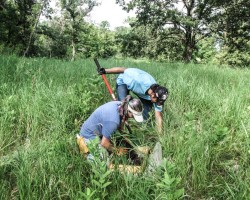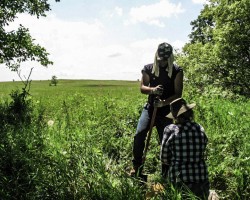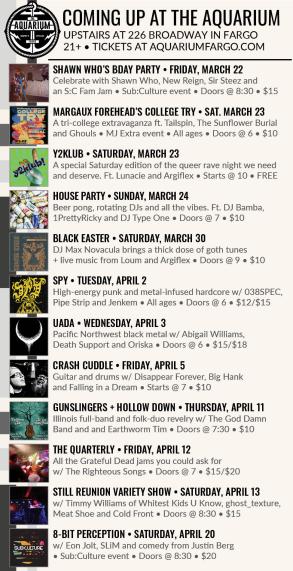Culture | September 17th, 2015

Dig it!
Archaeology week and archaeological finds in Clay County-a chat with MSUM’s Dr. George Holley
By Sabrina Hornung
HPR: What is your background and how long have you been at MSUM?
Dr. George Holley: I am originally from New Orleans, La and have been doing archaeology since 1973 in various parts of the United States (Arizona, Louisiana, Illinois, Missouri, Kentucky, Minnesota and North Dakota) and Belize. I am currently a professor in the Department of Anthropology and Earth Science at MSUM. I have been here since 1999.
HPR: What sparked your interest in anthropology/archaeology--what is your main area of interest?
GH: Like many a child I was interested in the past, particularly in the subject of what is called ancient history. In college, I soon learned that the route of ancient history required mastering a number of ancient languages. Given the opportunity to do local archaeology (excavating plantations and Native American sites), I realized that my passion was in telling a story, a story about what happened in the past as told from little bits of information that most people are not aware that exist. My main specialty is ceramic analysis and constructing what are called ceramic sequences. Ceramic sequences involve constructing units of time in a given region that reveal changing vogues, external connections, in short, the ebb and flow of the history of technology, style, and culture. I have worked on about half a dozen of these sequences and am presently working on one for southeastern North Dakota and southwestern Minnesota.
HPR: What lead you to believe that the Ponderosa Golf Course was a potential archaeological site -- how large was the area surveyed?
GH: Michael Michlovic, who recently retired, as professor of anthropology at MSUM, conducted work on the Regional Science Center for many years and documented the presence of an archaeological culture, Blackduck, on the elevated margins of the Buffalo River. These people were traditionally associated with Minnesota lakes country further east. His work documented that these Late Woodland peoples (800-1200 AD) were spending time in the Science Center processing bison that they likely procured in the expansive prairie to the west that makes up the Red River Valley. I wanted to find out the extent of this excavated site.
I took students from a class on the weekends and conducted shovel testing, which is digging a small hole in the ground and screening the contents. This shovel testing is done in a systematic manner to cover large sections of land that are not plowed and thus do not reveal their presence on the surface. This testing resulted in the identification of a buried site in the floodplain of the river that we excavated last summer. We also initiated a large-scale shovel testing program throughout the property, including the Ponderosa golf course. In all, we excavated more than 700 shovel tests and found a surprising diversity of archaeological properties, particularly in the floodplain of the former golf course. In short, the area is unique because it is one of 33 ancient deltas in the Red River valley stretching from Canada through Minnesota and North Dakota. These river systems offer timber, water, stone, and a mosaic of plant communities that are not available for most of the Red River valley. The region comprises a thin ribbon of timber along the Red River to the west, a vast flat and featureless prairie, a great bison habitat, and further east on the high, former beach rides of Lake Agassiz are these unique communities. At present, no one has identified these habitats as prime locations and the work at the Ponderosa has compelled me to rethink how native peoples used the area. The total area of the Regional Science Center is about 300 acres and while we did quite a lot of shovel testing, we did not cover more than about 40 per cent in general coverage.

HPR: I read in the article that dart tips and buffalo bones were discovered, but upon further excavation more bones and tools were discovered. What kind of tools were unearthed?
GH: At the site we first found shovel testing, excavations to a depth of 5 ft revealed successive occupations on the river bottoms. Based on stylistic evidence we think that the earliest, and deepest, spear or dart point, can date back to 8,000 years ago. We will apply more reliable dating methods in the future. The other tools include dart points, spear points, end scrapers, knives as well as a wealth of bone and rock remains. Three interesting things stand out about this site on first thought, and these are seemingly mundane and minor. First, we found a very tiny dart point, that was unrecognized in excavation. I now think that this is a toy point, used by a child to learn the art of hunting. This is such a real and tender bit from the past. Second, we found spear points that stylistically linked to the east and west, in other words, a polyglot of people engaged in hunting bison on this river bottom. Third, we found a small piece of obsidian, volcanic glass, that came all the way from the Rockies. The human, cultural, and spatial dimensions of this site are fascinating.
HPR: Can you tell us a bit about the Native people that inhabited the area?
GH: It depends upon what time. Archaeologists identify traditions that are not tied to any specific group. The people living at the buried site are identified as Archaic and they lived a nomadic existence for thousands of years most likely following bison herds. Later in time (around 100 BC or so) with the introduction of pottery, the Woodland period marks the beginning of a gradual change when people start to settle down. After about 1100 AD or so we talk of Prairie Villagers who were practicing agriculture to supplement the bison hunting. At times, the people who occupied the area were from the lakes country, at times they were local residents, at times they were from a much larger area.
HPR: Can you describe a hunting party at that time -- and what did they use to hunt?
GH: During the Archaic period, I suspect that we are dealing with a party of males doing the actual hunting, while the women, children, and older men would be involved in the processing of the bison. For the most part, hunting the bison was accomplished by several means of entrapment and killing slowly. We have not found the bison kill sites, all of our sites are gearing-up, waiting and watching the herds, and processing the kill that took place further west in the valley. We can tell this by the abundance of certain parts of the animal (legs, some ribs, heads) and the absence of others -- particularly the vertebrae.
The darts are small and would have entailed multiple piercings to bleed the animal, which may account for why we do not have evidence for initial processing. What we have is the field-dressed portion of the animal. One of the mysteries we have to solve is whether these large sites in the floodplain represent a small band of resident peoples processing bison over millennia, or whether it was the result of diverse people gathered in this unique location to seasonally (likely late fall) process bison killed in the valley.
HPR: Can you also tell our readers about the events surrounding archaeology week?
GH:Archaeology Week is a national event held in the United States and celebrated at the state level. There are many events going on across the state. For our event we will introduce the community to the setting of these sites and begin the process of telling the story about the past. Dr. Michlovic and I will be there to tour these sites, interpret what we found, give insights on what the land might have looked like back then, and to tell stories.
HPR: Could you also tell our readers about some other sites of archaeological significance in the area?
GH: Every county has significant sites. All of our significant sites would go unrecognized by the public as they lie in the ground. That is a difficult question to answer because the native peoples of North America were here for thousands of years, adapting to changing climate, refinements in technology, and all the while presenting to the world a success story that needs telling again and again. In the parlance of today, they practiced a sustainable lifestyles that we fail to appreciate and recognize as a society. From my perspective, all Native American sites are significant and are important bits that help tell a fascinating story.
April 18th 2024
April 18th 2024
March 21st 2024
March 21st 2024
March 21st 2024


__293px-wide.jpg)


